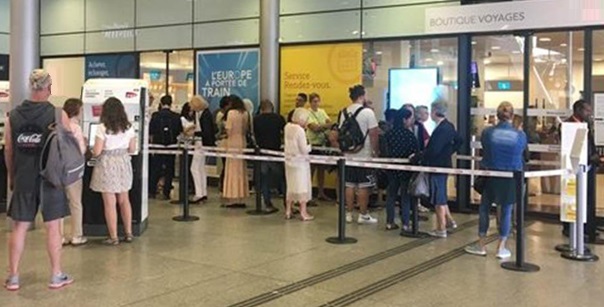Our Lynx crowd management software has now been enhanced to include a function for measuring waiting time, by analyzing the image of a crowd waiting to pass a check (e.g. identity, ticket, etc.) or an exchange (purchase, etc.). Measuring waiting time at a site is the result of a statistical operation whose definition seems simple enough, at first sight, but the devil is in the detail...
 In fact, in a simple waiting area seen by a single camera, the waiting time for the last person to arrive is the result of dividing the number of people present in the queue, say 10, by the average exit flow (the flow of people who have passed through the exchange at the end of the wait, whether it's a check-in or a purchase, for example). If an average of one person per minute exits in this case, the last person to arrive will wait 10 minutes. Displaying the waiting time to new arrivals is a very good way of avoiding stress and allowing the public to organize and occupy themselves for this wait, which is very beneficial for the public's experience of the service concerned.
In fact, in a simple waiting area seen by a single camera, the waiting time for the last person to arrive is the result of dividing the number of people present in the queue, say 10, by the average exit flow (the flow of people who have passed through the exchange at the end of the wait, whether it's a check-in or a purchase, for example). If an average of one person per minute exits in this case, the last person to arrive will wait 10 minutes. Displaying the waiting time to new arrivals is a very good way of avoiding stress and allowing the public to organize and occupy themselves for this wait, which is very beneficial for the public's experience of the service concerned.
But these simple principles become more complicated in reality, since the output flow can vary, with some exchanges being slower than others, creating a statistical hazard, whose average is a cause of imprecision, since it intervenes at the divisor of the waiting formula, and also because several cameras can contribute to the measurement of the queue or output flow, which complicates the formulation and makes a certain synchronization between measurements necessary. In this case, it is advisable to integrate a parameterized model of the waiting process, to take into account feedback from all cameras, to build up averages, but also to integrate a certain flexibility: the average must evolve with the process... but not too much!
For example, if we open an additional exchange counter, the flow of exits should increase fairly quickly, and so should the average, which will have the effect of reducing waiting time. On the other hand, if a large group joins the queue (a bus, a plane, etc.), the number of people waiting will rise sharply, increasing waiting time. On the other hand, if a few people (a family) are in the queue at the same time, the average number of people will rise sharply, and the waiting time should not be impacted too quickly.
The Dashboard in our Lynx product now takes all these constraints into account, allowing formulas to be built up on waiting zones, which are then averaged and synchronized by the software to determine waiting times. Results are displayed on counters or can be transmitted to third-party systems for display.


